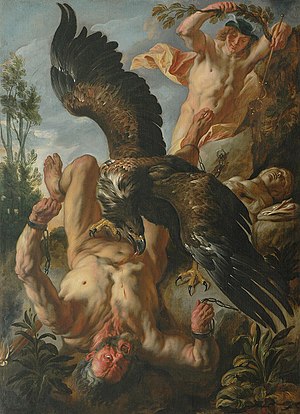Prometheus bound (painting)

|
| Prometheus bound (Inv number WRM 1044) |
|---|
| Jacob Jordaens , 1642 |
| Oil on canvas |
| 245 × 178 cm |
| Wallraf-Richartz Museum |
The painting Prometheus bound by Antwerp Jacob Jordaens (1593–1678) is one of the exhibits in the baroque department of the Wallraf-Richartz Museum in Cologne.
description
An aging, but still Herculean Prometheus with his mouth and eyes wide open in a cry of death seems to fall backwards into the great black hole of Hades . He wears iron chains around his wrists and ankles, one of which is still attached to the rock. An eagle of oversized wingspan, hacking its beak into the victim's liver, forms the diagonal of the canvas. From the top right, the youthful herald Hermes with a wide-brimmed hat, the Petasus , looks down. In his left hand he carries the Caduceus , the Caduceus , the rights includes a leafy branch behind it all the time seems to have kept hidden.
Picture theme
Around 1640, Jakob Jordaens staged the 'Fall of Prometheus from Hell', a popular motif of baroque subject painting , strikingly similar to his colleague Peter Paul Rubens around 1612.
Prometheus belongs to the Titan family of gods . Dominion over the world had been wrested from the Titans by Zeus and his Olympian gods. While titans like Atlas or Typhon had to perform slave services after their defeat against the Olympian gods, Prometheus, who had made this victory possible for the gods, initially remained in freedom - until he betrayed the fire to the people:
"See what I am sorry for gods!"
he speaks after thousands of years of silence about those five elements from which he as God once made man.
The poet Aeschylus obviously knew the speculation of the Pythagoreans of his time, according to which the soul was a " piece of ether ", and has interwoven it with the ancient myth that man is a creature, which the demiurge Prometheus made of fire, water, air and Created earth .
And the Creator loved his creatures. When it was decided which parts of the sacrificial animal should be for the gods and which for the people, Prometheus sided with his people and helped them outsmart the gods. He wrapped the worthless parts of the sacrificial animal with a lush piece of fat, which was still precious at the time. On the other hand, he placed bones on the good pieces. The gods recognized the deception, but they accepted it. The fur sack with the bones, on the right in the picture, illustrates this victim fraud. Even this act made Prometheus suspect to the Olympic gods.
But the people that Prometheus had created still lacked special qualities. They didn't have strong teeth and were neither particularly fast nor particularly strong. Therefore Prometheus stole embers for the people in the heaven of fire, which creates all arts , as Aeschylus writes. The burning torch commemorates this act of the titans, on the left in the picture near Prometheus' head. The bust on the right of the picture next to the offering indicates Prometheus' role as the creator of man.

By handing the fire over to the people, Prometheus committed - from the point of view of the Olympian gods - a great sacrilege, because the fire made people even more similar to the gods. Zeus punished Prometheus for this by having him forged on a rock in the Caucasus and sending him an eagle every day to eat his liver. This caused the Prometheus unimaginable pain, but did not kill him because his liver was constantly growing back. The painter Jakob Jordaens chose this moment of greatest suffering for his picture. He avoided excessive blood flow and gaping wounds. The torment and suffering of Prometheus is made believable by his body, by his tense muscles and above all by his crimson face, distorted by pain.
composition
Formally, Jordaens' Prometheus picture is based on depictions of the crucifixion of Peter , who was crucified upside down. He divides the picture by the wings of the eagle in the diagonal. The figure of Prometheus is inserted into the picture in such a way that his body - especially in the area of the legs - had to be depicted with strong foreshortened perspectives. With this, Jordaens demonstrated his painting skills to the viewer.
interpretation
An answer to the question of the interpretation of this picture can only be given very carefully. Prometheus was by no means judged unanimously in the 16th and 17th centuries. The assessment of the titan and his deeds fluctuated between admiration and total rejection. He was by no means considered an innocent sufferer. Rather, one saw in him a demonic Lucifer who knew how to deceive the highest God. A deep fall could not be avoided.
reception
The painting is mentioned in Susanne Röckel's novel Der Vogelgott (2018).
literature
- Lars Olof Larsson : Jacob Jordaens: Prometheus , in: Ancient myths in art. 100 masterpieces . Stuttgart: Reclam, 2009, ISBN 978-3-15-018592-6 , pp. 134f.
Web links
- Prometheus Shackled Resolution: 721 × 1000
- Report on the restoration and discovery of the exact date
Individual evidence
- ↑ a b Anja Sevcik: The bound Prometheus. In: Cologne cultural heritage. Retrieved October 31, 2018 .
- ↑ Aeschylus Prometeús desmótes 92: ἴδεσθέ μ 'οἷα πρὸς θεῶν πάσχω θεός Online
- ↑ Greek apóspasma aithéros .
- ↑ Salzburg / Vienna 2018. S. 172f.
